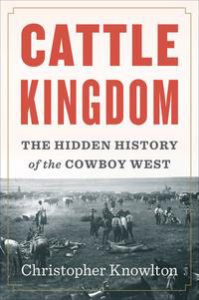 A revolutionary new appraisal of the Old West and the America it made
A revolutionary new appraisal of the Old West and the America it made
The open range cattle era lasted barely a quarter-century, but it left America irrevocably changed. These few decades following the Civil War brought America its greatest boom-and-bust cycle until the Depression, the invention of the assembly line, and the dawn of the conservation movement. It inspired legends, such as that icon of rugged individualism, the cowboy. Yet this extraordinary time and its import have remained unexamined for decades.
Cattle Kingdom reveals the truth of how the West rose and fell, and how its legacy defines us today. The tale takes us from dust-choked cattle drives to the unlikely splendors of boomtowns like Abilene, Kansas, and Cheyenne, Wyoming. We venture from the Texas Panhandle to the Dakota Badlands to the Chicago stockyards. We meet a diverse array of players—from the expert cowboy Teddy Blue to the failed rancher and future president Teddy Roosevelt. Knowlton shows us how they and others like them could achieve so many outsized feats: killing millions of bison in a decade, building the first opera house on the open range, driving cattle by the thousand, and much more. Cattle Kingdom is a revelatory new view of the Old West.
From Delancy Place:
THE BIRTH OF THE AMERICAN COWBOY — 1/08/18
Today’s selection — from Cattle Kingdom by Christopher Knowlton. In the mid-to-late 1800s, some 10 million cattle would be driven north out of Texas, the largest forced migration of animals in human history. It was the birth of the American cowboy:
“Cattle had been trailed from Texas to Missouri as early as 1842 and to California as early as 1854. … Although the maps depicting these routes suggest an orderly branch network of roads, on the ground the paths taken were often circuitous, as the drovers needed to provide water and grass for the cattle along the way. This meant following rivers and creeks and tracing the routes of old Indian and buffalo trails. The earliest endpoints were the railheads of the Union Pacific and the Missouri Pacific railroads, which were gradually extending their tentacles of track westward, now that the Civil War was over and capital was available for their expansion.
“But nothing about this trail-driving scheme turned out to be quite as easy as it looked on paper. The first challenge: a cattle drive required horses, but the freely roaming mustangs needed to be roped, corralled, and broken by a skilled broncobuster. It typically took five to six days to properly break a wild mustang. And to trail cattle north, a journey that could take three to six months, drovers needed four or five horses per cowboy.
 |
“The second challenge: the behavior and temperament of the wild Texas Longhorn itself. … It was a challenge for cowboys to round up these wild cattle. Texas Longhorns hid in the brush during the day and did most of their foraging at night. Only briefly in the summer, when the tormenting mosquitoes were out in force, did they spend the daylight hours in open areas, where they hoped to find a breeze. Most of the time the cowboys were compelled to ride into the thorny brush to flush the cattle out. But a cow with a young calf was prepared to gore a horse to defend her offspring, and the longhorn bull was notoriously ornery: ‘sullen, morose, solitary, and pugnacious;’ as one cattleman put it. ‘The longer he lived, the meaner he became.’ …
“Once a herd was assembled, the profit-seeking Texan faced his most grueling challenge: the trail drive itself, since railroads throughout the South had been badly damaged during the Civil War and had never ventured far into Texas. … It required a minimum of eight men to drive a thousand head of cattle. The trail boss usually rode a few miles ahead, scouting out water holes and good places to graze the herd. The cook followed on the mess, or chuck, wagon. …
“Two cowboys were positioned at the point of the herd and two along each swing, or flank. The two most junior cowboys brought up the rear and were known as drag riders. Their job was to keep the slow and lame cattle moving along. They were constantly subjected to dust and spatterings of the herd’s manure; they took the full brunt of its noxious odors. … [One] staple of the diet was ‘son-of-a-bitch stew,’ concocted from leftover cattle parts such as the heart, testicles, and tongue.
“On a good day, a trail drive could cover fourteen or fifteen miles, usually with a break at midday for lunch. The greatest threat facing the drovers was a stampede. It didn’t take much to spook the jumpy longhorns: lightning, the appearance of a wolf, the snap of a towel. …
“In the spring of 1867, some 35,000 head of cattle headed up the trails; the next year, 75,000; the year after that 350,000; and in 1871, some 600,000. The great migration of Texas Longhorns, the largest forced migration of animals in human history, had begun in earnest. In all, some ten million cattle would be driven north out of Texas, accompanied by half a million horses and some 50,000 cowboys.”
